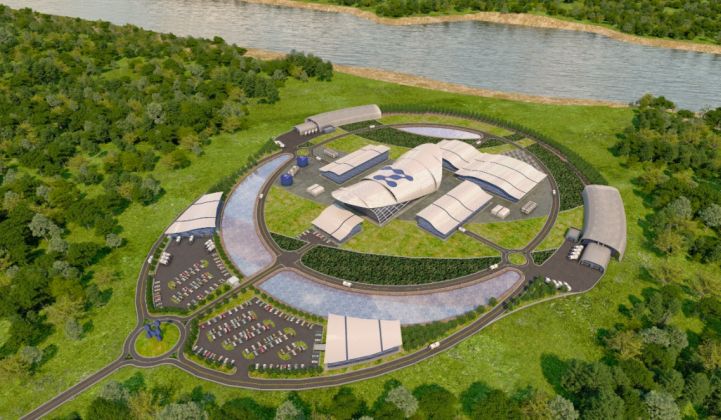Small-scale modular nuclear reactors have gone from being a technology that’s always a decade away from being built to one that may actually enter into commercial production in the next decade.
At least that’s how NuScale sees its future unfolding after winning a key approval from federal regulators, which determined that its small modular reactor design is safe enough to be built.
Last week’s final safety evaluation report gives a stamp of approval from the U.S. Nuclear Regulatory Commission to the safety features of NuScale’s modular reactor design. That’s a critical step for the Portland, Oregon-based company’s plans to build its first commercial systems.
Those include a deal with state power agency Utah Associated Municipal Power Systems to build 12 of its 50-megawatt modules by 2030 to deliver power across the Intermountain West as part of UAMPS’ Carbon Free Power Project. NuScale says it has also signed agreements with entities in the U.S., Canada, Romania, the Czech Republic and Jordan; it plans to deliver its first Power Module unit by 2027.
Last week’s approval marks the end of a process NuScale began with the Nuclear Regulatory Commission more than a decade ago. It's one of the many hurdles facing companies trying to bring a new generation of less-costly, smaller-scale nuclear reactors to market.
What sets NuScale apart in the SMR world
While small modular reactors have powered naval ships for decades and are also in use in other military applications, they’ve yet to be approved for use in commercial power generation.
But as the costs and complexities of building new large-scale nuclear power plants haunt major new projects like Southern Company’s Vogtle plant in Georgia, a host of companies are promising smaller-scale versions that could avoid their larger cousins’ pitfalls while offering similarly priced carbon-free power.
Other companies pursuing SMR designs include Bill Gates-backed TerraPower, Hyperion Power Generation, Terrestrial Energy, and the now-defunct Transatomic. The range of designs being pursued range from TerraPower’s traveling wave reactor and sodium fast reactor design to Terrestrial’s integral molten salt reactor and Hyperion’s “fission battery” concept.
NuScale was founded in 2007 with the goal of building the world’s smallest light water reactor, one that can use normal water as opposed to “heavy water,” or deuterium oxide — water with a greater atomic weight that is expensive to produce and can be difficult to source.
NuScale’s design doesn’t require some of the key safety features for large-scale reactors. For one, it uses mechanical water-cooling systems that don’t require additional water, pumps and valves or backup generators or batteries to run those systems in event of emergency.
“There’s a whole complex of tanks, pumps, valves and piping that doesn’t need to be built, inspected, tested and evaluated,” Matthew Wald, spokesperson for the industry group Nuclear Energy Institute, said in an email.
While NuScale’s reactors use roughly the same amount of water for cooling as do other large-scale nuclear or thermal generation plants, NuScale can also support air-cooled systems for use in water-constrained environments, with water usage rates that are lower than the most efficient combined-cycle, natural-gas-fired plants, according to company data.
In terms of cost, NuScale is targeting a levelized cost of energy of $65 per megawatt-hour and a cost to build that would equate to $2.9 billion for its 684-megawatt UAMPS project — roughly 20 percent lower than the initial costs of Southern Company’s Vogtle project, which have risen since construction began.
The advantages of nuclear modularity
NuScale and other SMR developers are betting that being able to build out generation capacity in a modular fashion should make for a much less risky prospect than large-scale power plants.
What’s more, they can ramp power up and down to help balance an increasingly intermittent power supply from wind and solar power by turning individual units on and off — a more efficient way to match changes in electricity supply and demand than is available from baseload large-scale nuclear power plants.
NuScale still has multiple steps ahead of it before it can build its first commercial reactor. It’s still awaiting a Standard Design Approval from the NRC, expected later this year, that will prepare the ground for NRC design certification in mid-2021.
U.S. SMR development lags behind countries such as Russia, which has the world’s only full-scale testing platform for SMRs, and other countries like China and India that are building sub-300-megawatt reactors, albeit using less modern designs.
The U.S. Department of Energy, which has supported most of the SMR companies of note, plans to develop a Versatile Test Reactor that can be used to mimic different SMR configurations and speed testing and certification of different designs.
NuScale investors include major government contractors and nuclear energy engineering firms such as Ares Corp., Enercon Services, Sargent & Lundy and majority investor Fluor, which has invested more than $475 million in the company, as well as South Korea’s Doosan Heavy Industries and Construction.
NuScale's 2013 agreement with the DOE has provided up to $226 million in assistance to win NRC approval in advance of its 2027 target for delivery of its first working module plant.




